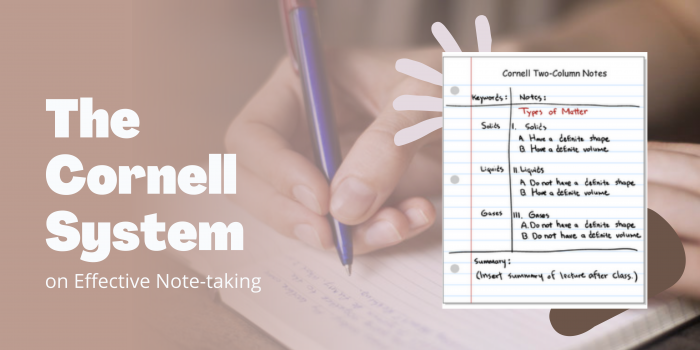Note taking is an essential aspect of student life. Well, not just studying, but in all sorts of jobs that require information retention and management. For the record, notes are handy. Even adults have jotters to scribble information and thoughts. But for students, effective note taking may be life changing. Thus, if you are a student, find the best note taking method for you.
One of the most iconic notes taking methods out there is the Cornell System, which was developed by Walter Pauk, who was an education professor at Cornell University. Is this another brain training mechanism? In true TLRC fashion, yes, it is.
The system is quite simple and works perfectly with those who love pen and paper. All you must do is to divide your note paper into three parts. On the left side is a column tagged as “Cue,” a larger right side tagged as “Notes,” and a smaller bottom portion tagged as “Summary.”
Let us break down the parts and look at their functions.
| Where do I put the larger chunk of my notes? | “Notes” is where you jot down the information you are taking in. Note that not all information being heard or seen during the note taking session must be written. Because the section only allows for limited notes, you are forced to identify the information that you think must be best remembered. This forces your brain to be more attentive to the information it gathers while you analyze and sort the information.
|
| Where do I put keywords and questions? | “Cue” is where you put what you intend to do with the information written in the “Note” column. This column is best worked on after you are done taking down notes. You can put questions that serve as a cue to retrieve information from your notes. You can also add plans or keywords if you feel like it. Writing cues allows your brain to retrieve information when portions of the information is being asked, thus, easier recall. Know however that some students also put cues and notes at the same time. If that works for you, do it.
|
| What do I do to recall the larger idea? | “Summary” portion may be one of the hardest to fill in as it forces you to look at the bigger picture and the general things that you have learned from the lecture. Just think of learning the details of the complicated process of gene regulation but the bottom line is that regulation allows your genes to be copied and used without problems which help you avoid diseases. Make the summary right after you are done with the lecture when your eureka moments are still fresh. Your brain will easily recall the general gist of what you have learned in no time.
|
The Cornell System is not foolproof because we all learn differently. But know that it is one way to organize your thoughts and actively process information while listening to lectures or quietly reading. Remember, take down essential information (notes), tag it (cue), and look at the bigger picture (summary).
Oh! Did I just take notes right now?
Pauk, Walter; Owens, Ross J. Q. (2010). How to Study in College (10 ed.). Boston, MA: Wadsworth. ISBN 978-1-4390-8446-5. Chapter 10: “The Cornell System: Take Effective Notes”, pp. 235-277

